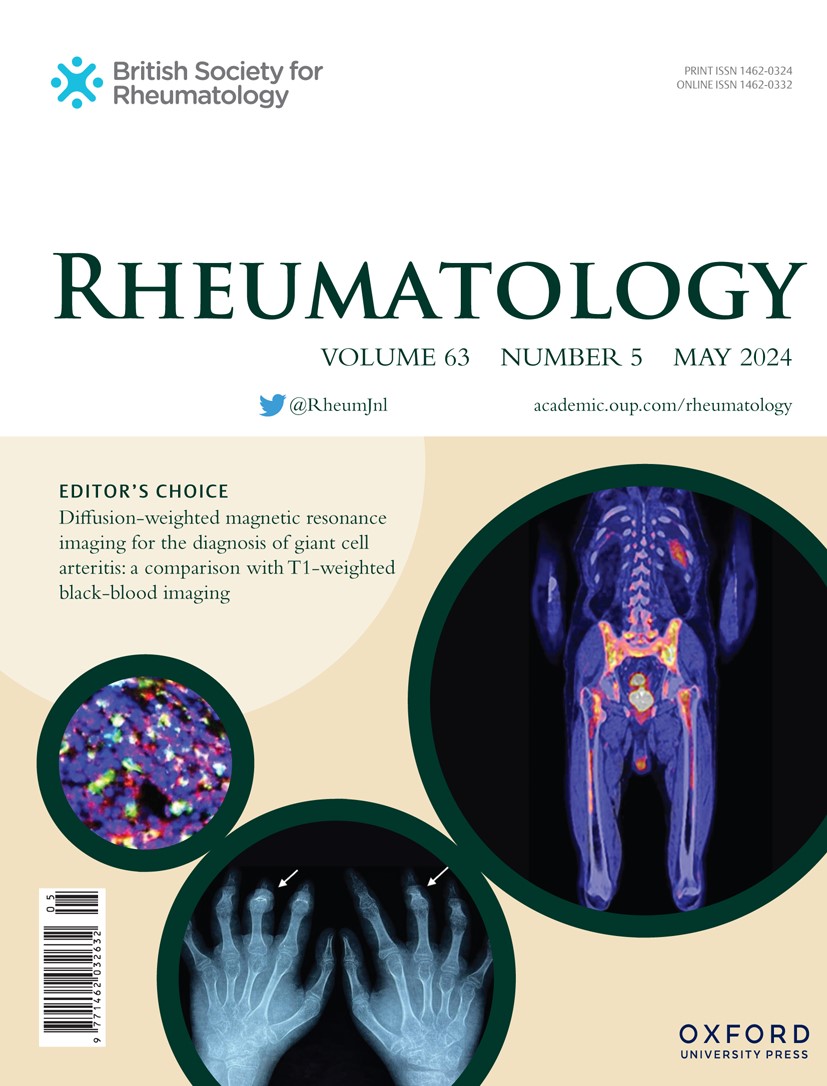P122 DAS28-CRP与SDAI评估类风湿关节炎活动性的比较研究
IF 4.7
2区 医学
Q1 RHEUMATOLOGY
引用次数: 0
摘要
背景/目的由于类风湿关节炎(RA)的临床表现高度异质性,在评估疾病活动性的不同指标之间的选择往往具有挑战性。本研究的目的是评估SDAI(简化疾病活动性指数)和DAS28-CRP(使用c反应蛋白的疾病活动性评分)在评估RA活动性方面的相似程度。方法本横断面研究共纳入183例根据ACR/EULAR 2009标准诊断为RA的患者。采用Pearson相关系数(r)评价两项指标的相关性,采用Kendall tau系数(K)评价两项评分的相似度。结果男女比例为9:1,平均年龄为58.54±12.23岁。血清阳性和关节畸形分别出现在87%和69%的患者中。平均DAS28-CRP评分为4.69±1.43[1.6-7.7],平均SDAI评分为29.62±14.04[2.5-66]。DAS28-CRP与SDAI指数呈显著正相关(p = 0.000)。在88%的病例中,DAS28-CRP将患者归类为与SDAI相同的疾病活动类别。具体来说,根据DAS28-CRP和SDAI, 68%的患者有活动性RA,根据两种评分,20%的患者处于缓解期。只有12%的患者观察到两种评分之间的差异。结论:我们的研究表明SDAI和DAS28-CRP评分之间具有高度的一致性。在日常实践中,DAS28仍然是最广泛使用的指数。然而,我们的结果表明SDAI应该更频繁地使用,因为它的可重复性和包含医生对RA活动的整体评估。詹雅:没有。El Mezouar:没有。N. Akasbi:没有。哈兹:没有。本文章由计算机程序翻译,如有差异,请以英文原文为准。
P122 Comparative study between DAS28-CRP and SDAI in assessing rheumatoid arthritis activity
Background/Aims The choice between different indices for assessing disease activity in rheumatoid arthritis (RA) is often challenging due to the highly heterogeneous clinical presentation. The objective of our study was to assess the level of similarity between the SDAI (Simplified Disease Activity Index) and DAS28-CRP (Disease Activity Score using C-reactive protein) in evaluating RA activity. Methods In this cross-sectional study, a total of 183 patients diagnosed with RA according to the ACR/EULAR 2009 criteria were included. The correlation between the two indices was assessed using Pearson’s correlation coefficient (r), and the similarity between these two scores was evaluated with Kendall’s tau coefficient (K). Results The female-to-male ratio was 9:1, and the average age was 58.54 ± 12.23 years. Seropositivity and joint deformity were present in 87% and 69% of the patients, respectively. The mean DAS28-CRP score was 4.69 ± 1.43 [1.6-7.7], and the mean SDAI score was 29.62 ± 14.04 [2.5-66]. A strong and statistically significant positive correlation was observed between the DAS28-CRP and SDAI indices (p = 0.000). The DAS28-CRP categorized patients into the same disease activity category as the SDAI in 88% of cases. Specifically, 68% of patients had active RA according to both DAS28-CRP and SDAI, and 20% were in remission based on both scores. A discrepancy between the two scores was observed in only 12% of patients. Conclusion Our study demonstrated a high level of concordance between the SDAI and DAS28-CRP scores. In daily practice, DAS28 remains the most widely used index. However, our results suggest that SDAI should be used more frequently due to its reproducibility and inclusion of a physician’s global assessment of RA activity. Disclosure M. Jnyah: None. I. El Mezouar: None. N. Akasbi: None. T. Harzy: None.
求助全文
通过发布文献求助,成功后即可免费获取论文全文。
去求助
来源期刊

Rheumatology
医学-风湿病学
CiteScore
9.40
自引率
7.30%
发文量
1091
审稿时长
2 months
期刊介绍:
Rheumatology strives to support research and discovery by publishing the highest quality original scientific papers with a focus on basic, clinical and translational research. The journal’s subject areas cover a wide range of paediatric and adult rheumatological conditions from an international perspective. It is an official journal of the British Society for Rheumatology, published by Oxford University Press.
Rheumatology publishes original articles, reviews, editorials, guidelines, concise reports, meta-analyses, original case reports, clinical vignettes, letters and matters arising from published material. The journal takes pride in serving the global rheumatology community, with a focus on high societal impact in the form of podcasts, videos and extended social media presence, and utilizing metrics such as Altmetric. Keep up to date by following the journal on Twitter @RheumJnl.
 求助内容:
求助内容: 应助结果提醒方式:
应助结果提醒方式:


